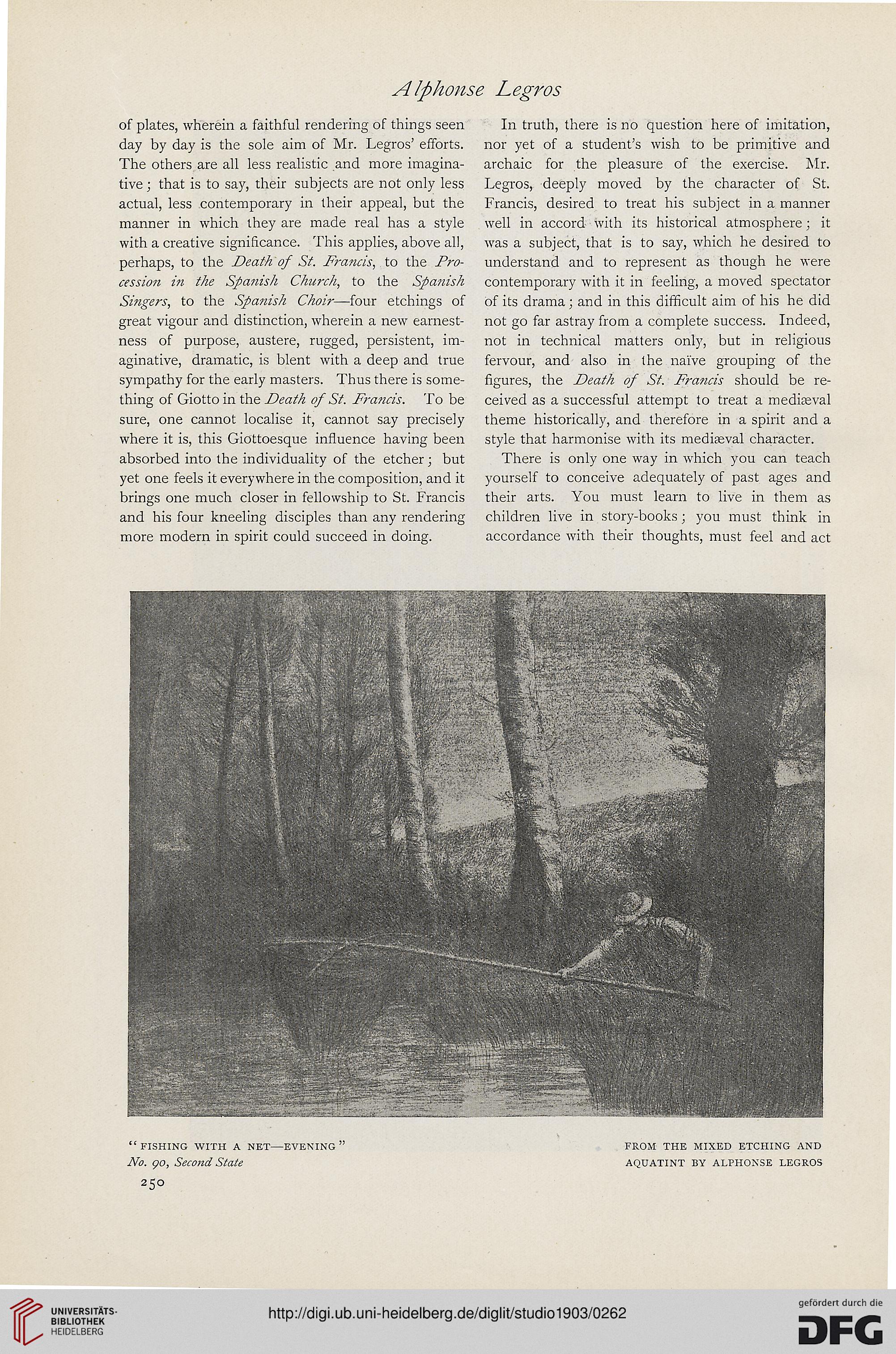AI fthouse Legfos
of plates, wherein a faithful rendering of things seen
day by day is the sole aim of Mr. Legros' efforts.
The others are all less realistic and more imagina-
tive ; that is to say, their subjects are not only less
actual, less contemporary in their appeal, but the
manner in which they are made real has a style
with a creative significance. This applies, above all,
perhaps, to the Death of St. Francis, to the Pro-
cession in the Spanish Church, to the Spanish
Singers, to the Spanish Choir—four etchings of
great vigour and distinction, wherein a new earnest-
ness of purpose, austere, rugged, persistent, im-
aginative, dramatic, is blent with a deep and true
sympathy for the early masters. Thus there is some-
thing of Giotto in the Death of St. Francis. To be
sure, one cannot localise it, cannot say precisely
where it is, this Giottoesque influence having been
absorbed into the individuality of the etcher; but
yet one feels it everywhere in the composition, and it
brings one much closer in fellowship to St. Francis
and his four kneeling disciples than any rendering
more modern in spirit could succeed in doing.
In truth, there is no question here of imitation,
nor yet of a student's wish to be primitive and
archaic for the pleasure of the exercise. Mr.
Legros, deeply moved by the character of St.
Francis, desired to treat his subject in a manner
well in accord with its historical atmosphere; it
was a subject, that is to say, which he desired to
understand and to represent as though he were
contemporary with it in feeling, a moved spectator
of its drama; and in this difficult aim of his he did
not go far astray from a complete success. Indeed,
not in technical matters only, but in religious
fervour, and also in Ihe naive grouping of the
figures, the Death of St. Francis should be re-
ceived as a successful attempt to treat a mediaeval
theme historically, and therefore in a spirit and a
style that harmonise with its mediaeval character.
There is only one way in which you can teach
yourself to conceive adequately of past ages and
their arts. You must learn to live in them as
children live in story-books; you must think in
accordance with their thoughts, must feel and act
" FISHING WITH A NET—:
No. go, Second State
250
■EVENING "
FROM THE MIXED ETCHING AND
AQUATINT BY ALPHONSE LEGROS
of plates, wherein a faithful rendering of things seen
day by day is the sole aim of Mr. Legros' efforts.
The others are all less realistic and more imagina-
tive ; that is to say, their subjects are not only less
actual, less contemporary in their appeal, but the
manner in which they are made real has a style
with a creative significance. This applies, above all,
perhaps, to the Death of St. Francis, to the Pro-
cession in the Spanish Church, to the Spanish
Singers, to the Spanish Choir—four etchings of
great vigour and distinction, wherein a new earnest-
ness of purpose, austere, rugged, persistent, im-
aginative, dramatic, is blent with a deep and true
sympathy for the early masters. Thus there is some-
thing of Giotto in the Death of St. Francis. To be
sure, one cannot localise it, cannot say precisely
where it is, this Giottoesque influence having been
absorbed into the individuality of the etcher; but
yet one feels it everywhere in the composition, and it
brings one much closer in fellowship to St. Francis
and his four kneeling disciples than any rendering
more modern in spirit could succeed in doing.
In truth, there is no question here of imitation,
nor yet of a student's wish to be primitive and
archaic for the pleasure of the exercise. Mr.
Legros, deeply moved by the character of St.
Francis, desired to treat his subject in a manner
well in accord with its historical atmosphere; it
was a subject, that is to say, which he desired to
understand and to represent as though he were
contemporary with it in feeling, a moved spectator
of its drama; and in this difficult aim of his he did
not go far astray from a complete success. Indeed,
not in technical matters only, but in religious
fervour, and also in Ihe naive grouping of the
figures, the Death of St. Francis should be re-
ceived as a successful attempt to treat a mediaeval
theme historically, and therefore in a spirit and a
style that harmonise with its mediaeval character.
There is only one way in which you can teach
yourself to conceive adequately of past ages and
their arts. You must learn to live in them as
children live in story-books; you must think in
accordance with their thoughts, must feel and act
" FISHING WITH A NET—:
No. go, Second State
250
■EVENING "
FROM THE MIXED ETCHING AND
AQUATINT BY ALPHONSE LEGROS




